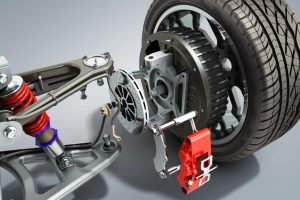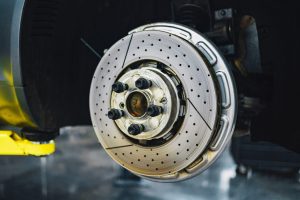Electric vehicles (EVs) are redefining automotive technology with cleaner energy use, instant torque, and quieter operation. But one of the most significant and often overlooked areas where EVs differ from traditional cars is in their braking systems. EVs feature innovative braking technologies that not only improve efficiency but also change the way we maintain and use our vehicles.
In this article, we’ll explore how braking systems in electric vehicles differ from those in internal combustion engine (ICE) vehicles, what drivers need to know, and how to ensure your EV’s brakes remain in optimal condition.
Why Braking Systems Are Different in EVs

The fundamental goal of any braking system — slowing down or stopping the vehicle — is the same for EVs and ICE vehicles. However, how EVs achieve this involves new technologies and a completely different driving dynamic.
The key differences include:
-
Regenerative braking
-
Lower mechanical brake usage
-
Electronic brake control
-
Different wear patterns
-
Battery integration
Core Components: EV vs. ICE Braking Systems
| Component | ICE Vehicles | Electric Vehicles |
|---|---|---|
| Brake Pedal | Traditional mechanical or hydraulic linkages | Similar but integrated with brake-by-wire systems |
| Brake Pads & Discs | Primary source of braking | Secondary to regenerative braking |
| Regenerative Braking | Not available | Standard in nearly all EVs |
| Brake Fluid Use | Regular, needs maintenance | Still used but less stressed |
| Wear Rate on Components | Moderate to high depending on use | Often lower due to regen braking |
| Electronic Controls | Limited (mostly in newer cars) | Heavily reliant on electronics and sensors |
What Is Regenerative Braking?
Regenerative braking (often shortened to “regen braking”) is a revolutionary feature in EVs that converts kinetic energy from braking into electrical energy, which is then stored in the battery. Instead of relying solely on brake pads and rotors, the electric motor runs in reverse during braking, slowing the car while generating electricity.
Benefits of Regenerative Braking:
-
Reduces wear on brake pads and discs
-
Increases driving range by conserving energy
-
Provides smoother deceleration in many conditions
Mechanical Brakes Are Still Essential
Even with advanced regenerative braking, EVs still need traditional friction brakes. These come into play when:
-
Braking hard or suddenly
-
Battery is full and can’t accept more regenerative charge
-
Speeds are very low
-
On steep declines or in emergency stops
EV Braking System Maintenance: What’s Unique?
While EVs typically experience less wear on brake pads and discs, they are not maintenance-free. In fact, infrequent use of mechanical brakes can cause other issues like corrosion or sticking calipers.
EV Brake Maintenance Checklist:
| Task | Frequency | Notes |
|---|---|---|
| Inspect brake pads & discs | Every 15,000–25,000 km | Less wear, but check for rust or sticking |
| Brake fluid replacement | Every 2–3 years | Moisture absorption still a concern |
| Caliper lubrication | Annually or during seasonal service | Prevent sticking from lack of use |
| ABS and regen check | With every major service | Ensure systems are synchronized and functioning well |
EV-Specific Braking Challenges
1. Brake Fade During Low Use
Because regen braking handles most slowdowns, pads may become glazed or corroded due to disuse.
Solution: Occasionally apply moderate pressure to the brake pedal during drives to keep the system active and clean.
2. Corrosion and Rust
Mechanical components like discs and calipers are exposed to moisture and road salts, but in EVs they are used less frequently, which increases the risk of rust.
Solution: Perform visual inspections regularly and consider anti-rust coatings or ceramic rotors if available.
3. Unusual Feel in Pedal Response
With regen braking and brake-by-wire systems, the brake pedal may feel different than traditional hydraulic systems.
Solution: Learn your EV’s braking behavior and have the system inspected if pedal feel changes suddenly.
Tips for Extending Brake Life in EVs

-
Use regenerative braking wisely — some EVs allow drivers to adjust regen strength.
-
Apply friction brakes occasionally — this cleans the rotors and keeps parts mobile.
-
Service the brakes on schedule — even if wear seems low.
-
Drive smoothly — EVs already encourage this, but it’s good for brake health too.
Brake Pad and Rotor Choices for EVs
Some EVs benefit from specialized low-dust or ceramic brake pads designed for the unique conditions of regenerative braking. These pads offer:
-
Reduced noise
-
Better resistance to corrosion
-
Less wear from infrequent use
Recommended EV-Compatible Brake Brands:
-
Brembo
-
ATE
-
Bosch
-
TRW
-
Zimmermann
You can find a wide range of high-quality, EV-compatible brake components when you Buy Brake System online.
Advantages of EV Braking Systems
| Feature | Benefit |
|---|---|
| Regenerative braking | Improves range and reduces mechanical brake wear |
| Brake-by-wire systems | More precise control and integration with electronic systems |
| Lower pad/disc replacement | Reduces maintenance costs over time |
| Energy recovery | Converts deceleration into usable power |
| Less heat generation | Less strain on system compared to friction-only braking |
Final Thoughts
Braking in electric vehicles is smarter, more efficient, and more advanced than in traditional cars — but that doesn’t mean it can be ignored. While regenerative braking reduces the workload on traditional components, drivers still need to maintain and understand the full braking system to stay safe and maximize performance.
By staying on top of maintenance and choosing high-quality replacement parts, you’ll ensure that your EV’s brakes continue to deliver top-tier safety and performance.
Looking to service or upgrade your EV’s braking system?
Buy Brake System online for premium-quality components compatible with modern electric vehicles.